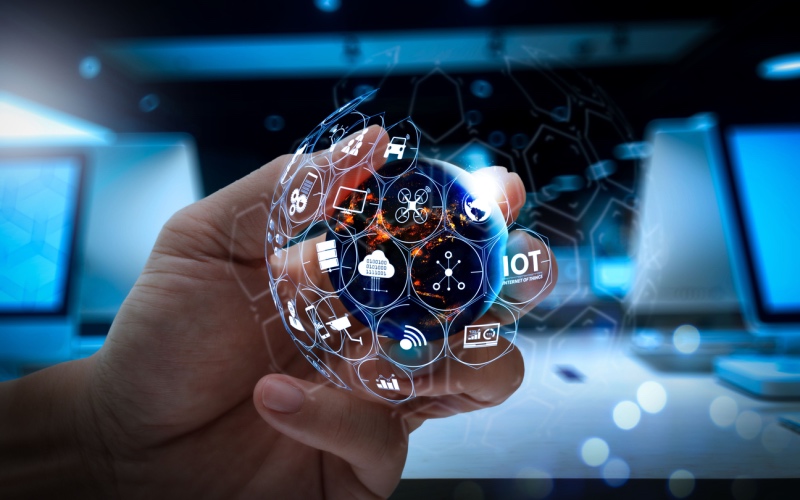The Internet of Things (IoT) is transforming industries by connecting billions of devices—from smart appliances and industrial sensors to autonomous vehicles and medical equipment—creating a vast, data-rich ecosystem. However, this connectivity also exposes serious vulnerabilities: centralized architectures, weak authentication protocols, and lack of data control often lead to data breaches, device spoofing, and privacy violations.
Blockchain technology offers a decentralized, tamper-proof, and transparent framework for managing data and device interactions across IoT networks. By eliminating single points of failure and introducing cryptographic trust, blockchain significantly enhances the security, privacy, and integrity of data exchanged between devices.
1. The Security Challenges in Traditional IoT Architectures
IoT systems are typically built on centralized cloud or client-server models. While convenient, these architectures suffer from critical flaws:
- Single points of failure: If the central server is compromised, all connected devices become vulnerable.
- Scalability issues: Central servers struggle to manage real-time data from millions of devices simultaneously.
- Weak identity management: Many IoT devices lack robust authentication, making them easy targets for hijacking.
- Unencrypted or unverified data: Data transmitted between devices can be intercepted, altered, or stolen.
- No user control over data: In many cases, data owners have no visibility or control over where and how their data is used.
These problems are magnified in sectors such as healthcare, transportation, energy, and smart cities, where real-time, mission-critical IoT operations are involved.
2. How Blockchain Enhances IoT Data Security and Privacy
Blockchain introduces a decentralized infrastructure where devices can securely authenticate, communicate, and transact without relying on a central authority. Key advantages include:
A. Decentralized Trust Model
Each device becomes a node in a peer-to-peer network. Transactions (data exchanges, commands, configurations) are validated by consensus rather than a central server.
- Eliminates single points of failure
- Reduces the risk of centralized attacks (e.g. DDoS)
- Builds trust among devices owned by different parties
B. Immutable Audit Trails
Blockchain ensures that all actions and data exchanges are recorded immutably:
- Device logs, firmware updates, and access requests are time-stamped and traceable
- Helps detect anomalies, unauthorized access, or data tampering
- Essential for regulatory compliance (e.g. HIPAA, GDPR, ISO 27001)
C. Cryptographic Device Identity
Each device is assigned a unique blockchain-based identity, often derived from public-private key pairs.
- Prevents spoofing and unauthorized access
- Enables secure authentication without passwords or certificates
- Devices can verify each other’s authenticity before exchanging data
D. Data Ownership and Access Control
Blockchain enables decentralized data permissioning:
- Data owners can define who can access, modify, or share data
- Smart contracts can automatically enforce access rules
- Fine-grained control over sensor data, location data, or user information
This is crucial for protecting sensitive data, such as:
- Medical records from wearable devices
- Location data from smart vehicles
- Usage patterns from smart home systems
E. Peer-to-Peer Communication and Automation
Smart contracts facilitate secure, automated coordination between devices:
- A smart thermostat can pay a solar panel system for energy in real time
- A drone can verify delivery details on-chain before releasing a package
- Autonomous vehicles can negotiate right-of-way or charging schedules without human intervention
3. Real-World Use Cases
Smart Homes
Blockchain secures communication between devices like locks, cameras, thermostats, and voice assistants. Only verified users and devices can access or control resources, and usage logs are securely stored for accountability.
Healthcare IoT (IoMT)
Wearables and remote monitoring devices can securely transmit patient data to hospitals. Blockchain ensures data integrity and enables patients to control who sees their health data, complying with privacy regulations.
Industrial IoT (IIoT)
Machines and sensors in a factory can use blockchain to verify software updates, track maintenance history, and coordinate operations without exposing the system to external control risks.
Smart Cities
Traffic sensors, cameras, and energy systems can share data across municipal departments without risking privacy. Blockchain enables a shared yet secure infrastructure for public and private collaboration.
Supply Chain IoT
RFID tags, GPS trackers, and environmental sensors can log real-time data about goods in transit—temperature, location, condition—onto the blockchain, creating an end-to-end verifiable chain of custody.

4. Complementary Technologies
To fully secure IoT with blockchain, integration with other technologies is often required:
- Edge Computing: Reduces latency and bandwidth by processing data locally on devices before writing to blockchain.
- Zero-Knowledge Proofs: Allow validation of data without revealing the actual content—useful for privacy-sensitive IoT applications.
- Decentralized Identifiers (DIDs): Enable verifiable, self-sovereign identities for devices and users.
- InterPlanetary File System (IPFS): Stores large IoT data off-chain while recording hashes on-chain for integrity verification.
5. Challenges to Implementation
Despite its promise, applying blockchain in IoT is not without hurdles:
- Resource Constraints: Many IoT devices have limited processing power, memory, and battery—unsuited for heavyweight blockchain operations.
- Network Latency and Throughput: Public blockchains can struggle with high-frequency IoT data.
- Scalability: Large-scale IoT networks require highly scalable blockchain infrastructure.
- Standardization Gaps: Lack of interoperability between different IoT and blockchain platforms.
- Regulatory Uncertainty: Legal frameworks for decentralized IoT data exchange are still evolving.
Solutions such as lightweight nodes, consortium chains, layer-2 protocols, and off-chain processing are emerging to address these issues.
6. The Future of Blockchain + IoT Security
As blockchain matures and IoT adoption accelerates, their convergence will become foundational to digital infrastructure. We can expect:
- Global registries of verified devices using blockchain identities
- Autonomous machine-to-machine economies, where devices transact and coordinate via smart contracts
- Standardized data permissioning frameworks across vendors, sectors, and borders
- Full lifecycle traceability of connected devices—from manufacturing to decommissioning
- AI + Blockchain integration, where machine learning models operate securely on verified, tamper-proof IoT data
The result will be a trust fabric for the machine world—where devices not only communicate securely, but act intelligently and independently within a provable, decentralized framework.
Conclusion
Blockchain solves some of the most critical security and privacy challenges in IoT by introducing a decentralized, transparent, and tamper-resistant layer of trust. It secures data flows, authenticates devices, enforces user control over data, and enables automated, rule-based interactions—all without relying on vulnerable central servers.
For enterprises, governments, and consumers seeking to deploy IoT at scale, integrating blockchain is no longer optional—it’s a strategic imperative for building secure, interoperable, and trustworthy connected systems.


















































